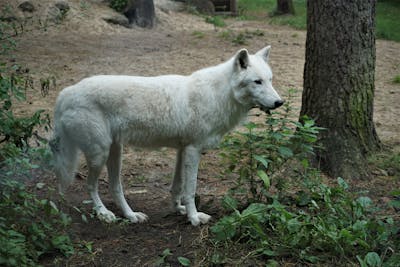The Arctic wolf, or Canis lupus arctos, is a subspecies of the gray wolf that inhabits the Arctic regions of North America and Greenland. These wolves have adapted to the harsh, cold environments of the Arctic, and are considered one of the toughest and most resilient animals in the world.
Arctic wolves have several physical adaptations that allow them to survive in their environment. They have a thick, white coat of fur that helps them blend in with their surroundings and keeps them warm in the frigid temperatures of the Arctic. Their fur is also denser and longer than that of other wolf subspecies, providing added insulation. Arctic wolves have smaller ears and shorter snouts than other wolves, which also helps to reduce heat loss in cold temperatures.
Arctic wolves are also skilled hunters and have adapted their hunting strategies to the unique challenges of the Arctic environment. They primarily prey on muskoxen, Arctic hares, and caribou, which are well adapted to the cold and can run for long distances. To catch these prey, Arctic wolves will work in packs, using their intelligence and teamwork to outsmart their prey. They will often track herds of caribou for days, waiting for an opportunity to strike.
Arctic wolves are social animals and live in packs of up to ten individuals. The pack is led by an alpha male and female, who are typically the strongest and most experienced members of the group. The pack works together to hunt and defend their territory, and they have a complex social structure with clear hierarchies and rules.
Despite their resilience and adaptability, Arctic wolves face several threats to their survival. Climate change is affecting their habitats, causing a loss of sea ice and changing the migratory patterns of their prey. Human activities, such as hunting and oil and gas development, also pose a threat to Arctic wolf populations.
Efforts are underway to protect and conserve Arctic wolf populations. This includes measures to reduce human impact on their habitats, as well as programs to monitor and manage wolf populations. Research is also being conducted to better understand Arctic wolf behavior and ecology, which will help inform conservation efforts.
In conclusion, the Arctic wolf is a fascinating and resilient subspecies of the gray wolf that has adapted to the harsh environments of the Arctic. With their thick fur, hunting skills, and social intelligence, these wolves are well suited to their environment. However, they face significant threats from climate change and human activities, and efforts are needed to protect and conserve their populations. The Arctic wolf serves as a reminder of the importance of preserving and protecting the natural world and its incredible biodiversity.


Comments
Post a Comment